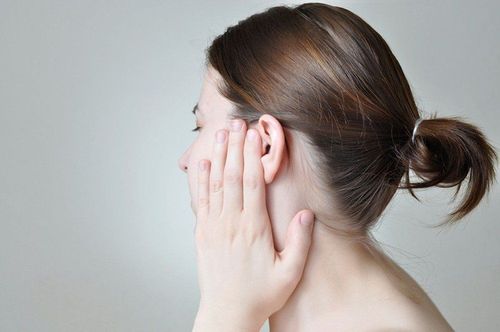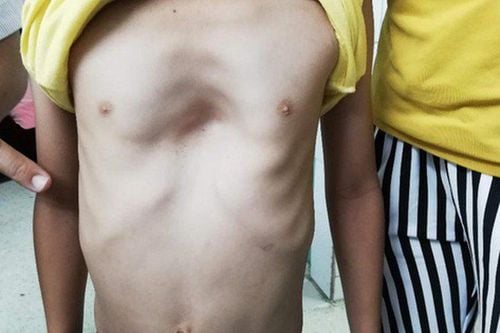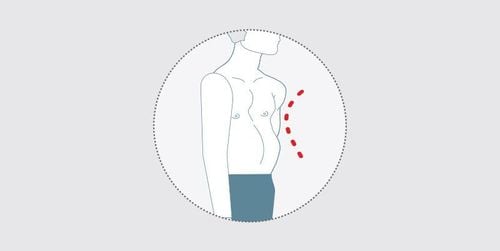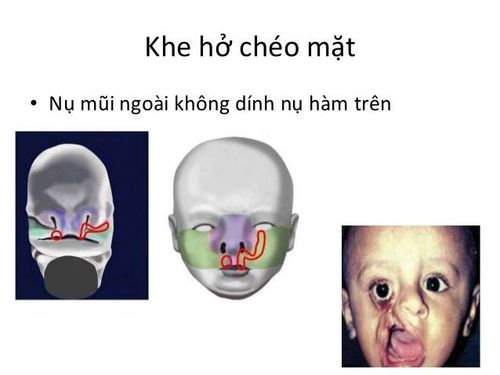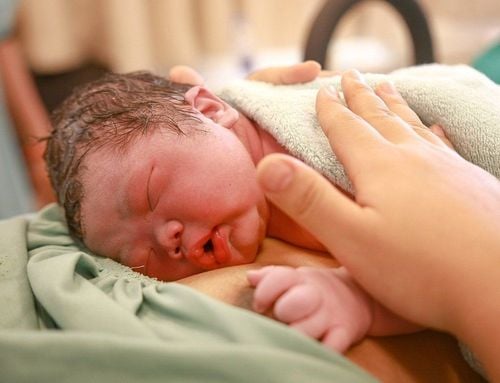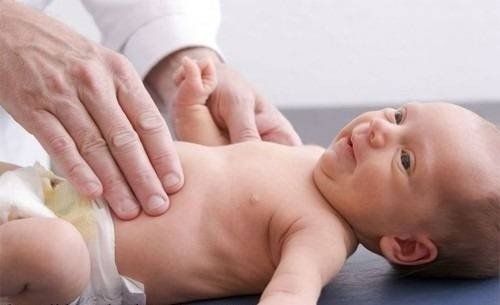This is an automatically translated article.
Dimples on the chest of a young child can be a sign of congenital chest depression, which is quite dangerous. Treatment of congenital chest concavity is applied with many methods such as setting the bell to raise the sternum, Nuss surgery to shape the sternum...1. What is a sternum concave malformation?
Congenital dimple (also called “Chest channel”), is a birth defect caused by the abnormal development of the sternum and some costal cartilage, causing the chest wall to be abnormally concave. Sternal depression is also the most common chest wall malformation in children, with a rate of 1/300 children, more males than females (3:1). Because the sternum is too pushed back, affecting heart and lung function, children often have typical symptoms of shortness of breath, chest tightness, anorexia, and a deep depression on the chest.
For the treatment of this condition, a popular choice for patients undergoing sternotomy with a breast lifter (Nuss surgery).
2. Method of shaping the sternum in the treatment of congenital chest concavity

Chống chỉ định với bệnh nhân mắc bệnh tim bẩm sinh
Nuss surgery is a minimally invasive surgical method developed by Dr. Donald Nuss has performed since 1987 and has been widely popular around the world to help treat congenital concave breasts. The advantages of the method are minimally invasive, low blood loss and short recovery time.
2.1 Indicated cases Nuss surgery is usually indicated in the following cases:
Patients with moderate to much concave chest (Haller index > 3.2); Patients have functional symptoms such as chest pain, shortness of breath, reduced exertion... Affecting the patient's aesthetics, psychology, and health. 2.2 Contraindications Patients with complex congenital malformations such as congenital heart disease, affecting heart function, mental illness, mental retardation, sequelae of adhesions of the pleura, membranes Severe heart disease...needs to be evaluated and evaluated carefully regarding the use of this method.
2.3 Preparation before treatment 2.3.1 Surgical instruments Thoracic surgery kit and automatic control CO2 injection system; Camera 0o, 5mm; Thoracic surgery instrument, the kit comes with the instrument.
Before carrying out breast reconstruction surgery, the patient was carefully examined clinically, probed, preoperative echocardiogram, measured respiratory function, examined anesthesia and resuscitated, and assessed damage on CT scans. . Patients and families are explained and guided about the surgical procedure as prescribed, and legal documents are completed.
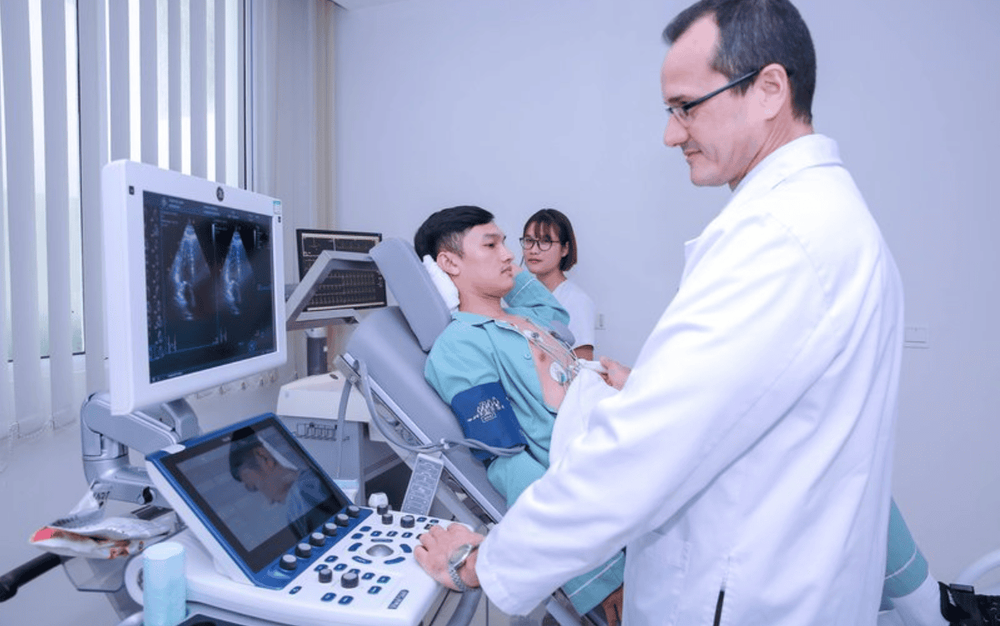
Bệnh nhân cần siêu âm tim trước khi tiến hành phẫu thuật tạo hình xương ức
2.3 Preparation before treatment 2.3.1 Surgical instruments Thoracic surgery kit and automatic control CO2 injection system; Camera 0o, 5mm; Thoracic surgery instrument, the kit comes with the instrument.
Before carrying out breast reconstruction surgery, the patient was carefully examined clinically, probed, preoperative echocardiogram, measured respiratory function, examined anesthesia and resuscitated, and assessed damage on CT scans. . Patients and families are explained and guided about the surgical procedure as prescribed, and legal documents are completed.
2.3.2 Patient position
At the beginning of surgery, the patient is placed in a supine position with a pillow about 5cm below the back. The anesthesiologist will administer endotracheal anesthesia.
2.3.3 The process of breastbone plastic surgery Measure and mark the deepest depressions, the axillary line between the two sides. Select the lifting bar and bend the bar according to the patient's chest shape. Adjust the sample bar and bar bar accordingly. Put Thompson valve in the corresponding position, carry out suture of sternum for deep concave cases. Place a Trocar and a 0-degree, 5mm bronchoscope at 2 intercostal spaces inferior to the right entrance of the chest bar. Inflate CO2 at a pressure of 5mmHg, 1 liter/min, combined with thoracoscopy to evaluate the thoracic cavity.
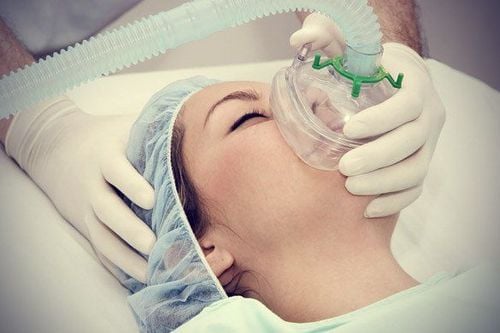
Gây mê nội khí quản trước khi phẫu thuật
Make an incision of about 3cm on both sides of the chest wall corresponding to the position of the bar, dissection under the weight to the position of threading the bar. Under endoscopic guidance, pincetically dissected the pleural space behind the sternum, through the anterior pericardium, into the contralateral pleural space, through the lateral opening, and clamped the bar guide wire. Connect the bar and the guide wire, thread the bar into the respective position. Fix the bar by using steel thread to sew around the ribs, one side is to use Vicryl thread to fix the bar to the fascia of the chest wall. Use Vicryl 2 thread to fix the bar to the chest wall. Intrathoracic assessment by endoscopic method. Squeeze the balloon to expand the lung, withdraw the endoscopic Trocar, close the incisions, and finish the surgery.
3. Monitoring and handling complications after Nuss . surgery
After sternotomy, it is important to pay attention to the patient's pain and respiratory status. Some common complications and complications can include:3.1 Pneumothorax In case of small pneumothorax without intervention, pneumothorax is large and the patient shows respiratory failure, put a pleural drainage through the hole. place Trocar.
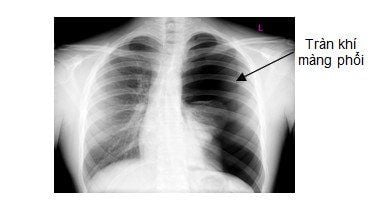
Bệnh nhân có thể bị biến chứng tràn khí màng phổi sau phẫu thuật Nuss
3.2 Pleural effusion Conduct pleural drainage.
3.3 Cardiopulmonary injury Requires open thoracic surgery to treat.
3.4 Displacement of the bar It may be due to an inappropriate pressure point or an overactive child, and it is necessary to adjust and fix the bar.
3.5 Allergies, infection of the support rod When the incision shows signs of prolonged bleeding that cannot be healed, it is necessary to remove the support rod.
Some other complications such as: Bleeding, damage to lungs, pericardium, heart.
4. Care after sternotomy surgery
Families need to pay attention to bring the patient back to the hospital after surgery according to the schedule: First week after discharge, 1-3-6-12 months and 24-36 months after surgery.
After discharge from the hospital, instruct the patient to practice breathing, avoid turning and bending the chest in the first month after surgery. After 24-36 months postoperatively, chest concavity can be reassessed and instrument removal considered.
In summary, concave chest disease accounts for the highest percentage of congenital malformations of the chest wall, so parents should have the right understanding of this disease to best care for and treat their children. Visit a reputable hospital to be consulted by a specialist to come up with the most suitable treatment plan. The pediatric department at Vinmec International General Hospital is the address for receiving and examining diseases that infants and young children are susceptible to: viral fever, bacterial fever, otitis media, pneumonia in children. With a system of facilities, modern medical equipment, sterile space, minimizing the impact as well as the risk of disease spread, Vinmec will bring satisfaction to customers. and is highly appreciated by industry experts with:
Gathering a team of leading pediatricians: including leading experts with high professional qualifications (professors, associate professors, doctors, Master's degree), experienced, worked at major hospitals such as Bach Mai, 108.. The doctors are all well-trained, professional, conscientious, knowledgeable about young psychology. In addition to domestic pediatric specialists, the Department of Pediatrics also has the participation of foreign experts (Japan, Singapore, Australia, USA) who are always pioneers in applying the latest and most effective treatment regimens. . Comprehensive services: In the field of Pediatrics, Vinmec provides a series of continuous medical examination and treatment services from Newborn to Pediatric and Vaccine,... according to international standards to help parents take care of their baby's health from birth to childhood. Advanced techniques: Vinmec has successfully deployed many specialized techniques to make the treatment of difficult diseases in Pediatrics more effective: neurosurgery - skull surgery, stem cell transplantation blood in cancer treatment. Professional care: In addition to understanding children's psychology, Vinmec also pays special attention to the children's play space, helping them to play comfortably and get used to the hospital's environment, cooperate in treatment, improve the efficiency of medical treatment.
Please dial HOTLINE for more information or register for an appointment HERE. Download MyVinmec app to make appointments faster and to manage your bookings easily.




